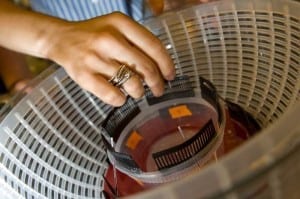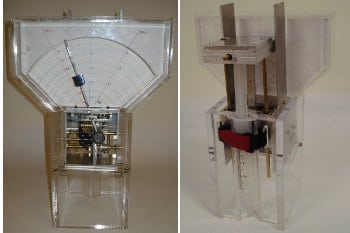
Photo courtesy of Lauren Theis and Lila Kerr
Anemia is easy to diagnose in developed nations, but testing for it in impoverished regions can present a problem. Well equipped clinics and hospitals test blood samples with a centrifuge. Yet many rural clinics have only intermittent power or are off the grid and lack electricity to run such devices. So, while centrifuges can be cheap, getting one and running one isn’t always an option.
A simple salad spinner may be a solution. Two students at Rice University modified an ordinary, off-the-shelf veggie dryer to make it clasp vials of blood. The result is a hand-pumped blood separator.
How to test for anemia
Anemia is a decrease in the number of red blood cells or hemoglobin, the protein in the red blood cells that contains iron and transports oxygen. To test for it, a centrifuge spins tubes with a small amount of blood—15 microliters—until the heavier red blood cells separate from the lighter blood plasma. Measuring what’s in the tubes—the ratio of red cells to plasma, or hematocrit—can indicate anemia.
The modified salad spinner holds 30 vials and separates blood in ten minutes of hand pumping.
Why it matters
Anemia afflicts nearly a quarter of the world’s population, according to a 2008 World Health Organization study. The highest rates are among women and preschool-age children, with Africa and Southeast Asia topping the chart.
There are many possible causes of anemia in the developing world. These range from chronic infections, such as those caused by such parasites as hookworms and the flukes that cause schistosomiasis, to malaria, tuberculosis, HIV/AIDS, and even heavy loss blood during menstruation.

Photo courtesy of Lauren Theis and Lila Kerr
How it happened
Lauren Theis and Lila Kerr set out to improve a problematic centrifuge prototype based on an eggbeater. The beater was tough to use and not sealed well, posing an infection risk for the operator. After a few tries with other designs, the pair hit on the salad spinner: It’s hand-powered, easy to use, and enclosed for safety. They modified the first prototype with combs and hot glue to make the clasp for the microcapillary tubes that hold blood samples, and left the pump and spinner untouched.
They dubbed it Sally Centrifuge and helped student teams put it to work in Ecuador, Malawi, and Swaziland this year. In Ecuador, “the doctors and nurses were excited at the prospect of such an inexpensive, easy to use, and portable device that could rapidly diagnose this condition,” Theis told E4C.
Lessons learned
The design needs a way to standardize the spinning speed, Theis said. Otherwise, it’s not clear to new users how fast they should spin it. Also, it won’t be useful everywhere. It was well-received in Ecuador and Malawi, but the clinicians they spoke to in Swaziland had access to centrifuges in labs.
The students continue to test and tinker with the prototype. They’ve replaced some of the original salad spinner parts with custom designs from a 3D printer. They’re also preparing a paper on the device that they hope to publish in a peer-reviewed journal. So far, there are no plans for manufacture or distribution. For more information, please see the site for Rice’s 360 global development program.

